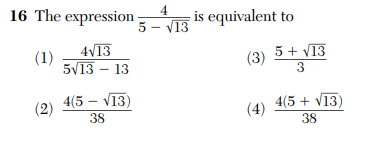Now that I'm caught up with the current New York State Regents exams, I'm revisiting some older ones.
More Regents problems.
Algebra 2/Trigonometry Regents, June 2011
Part I: Each correct answer will receive 2 credits.
16. The expression 4 / (5 - √(13)) is equivalent to
Answer: Either (1) or (3)
You read that correctly. The Regents people messed up on this question. Either they didn't ask what they meant to ask, or they goofed up on the choices.
If you multiply the numerator and the demoninator by √(13), you get Choice (1). There is no reason why anyone would do that -- it doesn't simplify anything nor does it rationalize the denominator. But it IS an equivalent expression to the one in the question.
What they were looking for, and what you probably calculated (or should have) is the following:
Multiply the numerator and denominator by the conjugate of the denominator to get the radical out of the denominator. Then simplify the fraction:
This gives you Choice (3), which is probably what they originally intended, but not what they actually asked.
12. Akeem invests $25,000 in an account that pays 4.75% annual interest
compounded continuously. Using the formula A = Pert, where
A = the amount in the account after t years, P = principal invested,
and r = the annual interest rate, how many years, to the nearest tenth,
will it take for Akeem’s investment to triple?
1) 10.0
2) 14.6
3) 23.1
4) 24.0
Answer: 3) 23.1
You can check all four choices in your graphing calculator. Or you could graph the function and check the table of values. Or you can use logs.
The equation A = Pert becomes 75000 = 25000e0.0475t
25000e0.0475(10) = 40,200
25000e0.0475(14.6) = 50,018
25000e0.0475(23.1) = 74,898
25000e0.0475(24) = 78,169
The answer is obviously 23.1 years.
Here is a sample Table of Values from a function -- I deleted some of the entries to make it smaller.
Had it not been a multiple-choice question, we'd have to do it the longer way.
75000 = 25000e0.0475t
3 = e0.0475t
ln 3 = 0.0475t
t = ln 3 / 0.0475 = 21.1287...
18. The value of the expression Σ(r=3:5) (-r2 + r) is
being selected?
1) -38
2) -12
3) 26
4) 62
Answer: 1) -38
There are only 3 numbers being added so work out each of them. It looks "obvious" that the answer will be negative.
r = 3: (-(3)2 + (3)) = -6
r = 4: (-(4)2 + (4)) = -12
r = 5: (-(5)2 + (5)) = -20
-6 + -12 + -20 = -38
19. WHich graph shows y = cos-1x?
Answer: 3) [See Image]
Since cos (0) = 1 then cos-1 (1) = 0.
Only Choice (3) has point (1,0). It is the correct choice.
If you look at the graph of y = cos x, and then reflect it over the line y = x, you will get Choice (3).
20. If r = ∛(A2B/C), then log r can be represented by
1) 1/6 log A + 1/3 log B - log C
2) 3(log A2 + log B - log C)
3) 1/3 log(A2 + B) - C
4) 2/3 log A + 1/3 log B - 1/3 log C
Answer: 4) 2/3 log A + 1/3 log B - 1/3 log C
Switch the cube root to an exponent of (1/3) and then use the rules for logarithms:
r = (A2B/C)(1/3)
log r = log (A2B/C)(1/3)
log r = 1/3 log (A2B/C)
log r = 1/3 log A2 + 1/3 log B - 1/3 log C
log r = 2/3 log A + 1/3 log B - 1/3 log C
More to come. Comments and questions welcome.
More Regents problems.
I also write Fiction!You can now preorder Devilish And Divine, edited by John L. French and Danielle Ackley-McPhail, which contains (among many, many others) three stories by me, Christopher J. Burke about those above us and from down below. Preorder the softcover or ebook at Amazon. Also, check out In A Flash 2020, by Christopher J. Burke for 20 great flash fiction stories, perfectly sized for your train rides. Available in softcover or ebook at Amazon. If you enjoy it, please consider leaving a rating or review on Amazon or on Good Reads. |
 |
 |




















No comments:
Post a Comment